tow OLDSMOBILE SILHOUETTE 1993 Owners Manual
[x] Cancel search | Manufacturer: OLDSMOBILE, Model Year: 1993, Model line: SILHOUETTE, Model: OLDSMOBILE SILHOUETTE 1993Pages: 323, PDF Size: 17.13 MB
Page 20 of 323

Seats di Safety Belts
Removing Rear Bucket Seats
Removing the RIGHT ONLY Seats:
1 . Lift the upper lever to fold the
2. Push the lower lever back so the
seatback forward.
entire
seat and seatback tilt forward
3. Then, from behind the seat, support
the top portion of
the seat with one
hand as you squeeze the front release
bar toward the crossbar. The seat will
release
from the floor pins.
Removing LEFT ONLY and
CENTER OR LEFT Seats:
1. Lift the upper lever to fold the
seatback forward.
ProCarManuals.com
Page 21 of 323
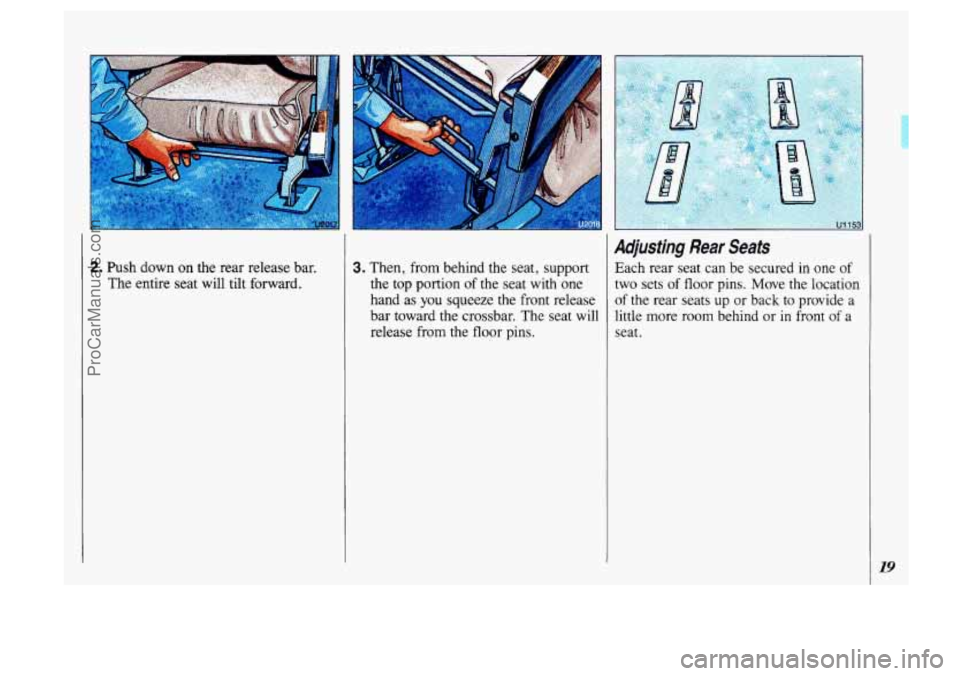
2. Push down on the rear release bar.
The entire seat will tilt forward. 3. Then, mom behind the seat, support
the top portion of the seat with one
hand as you squeeze the front release
bar toward the crossbar. The seat will
release from the floor pins.
Adjusting Rear Seats
Each rear seat can be secured in one of
two sets of floor pins. Move the location
of the rear seats up or back to provide a
little more room behind or in front of a
seat.
ProCarManuals.com
Page 43 of 323
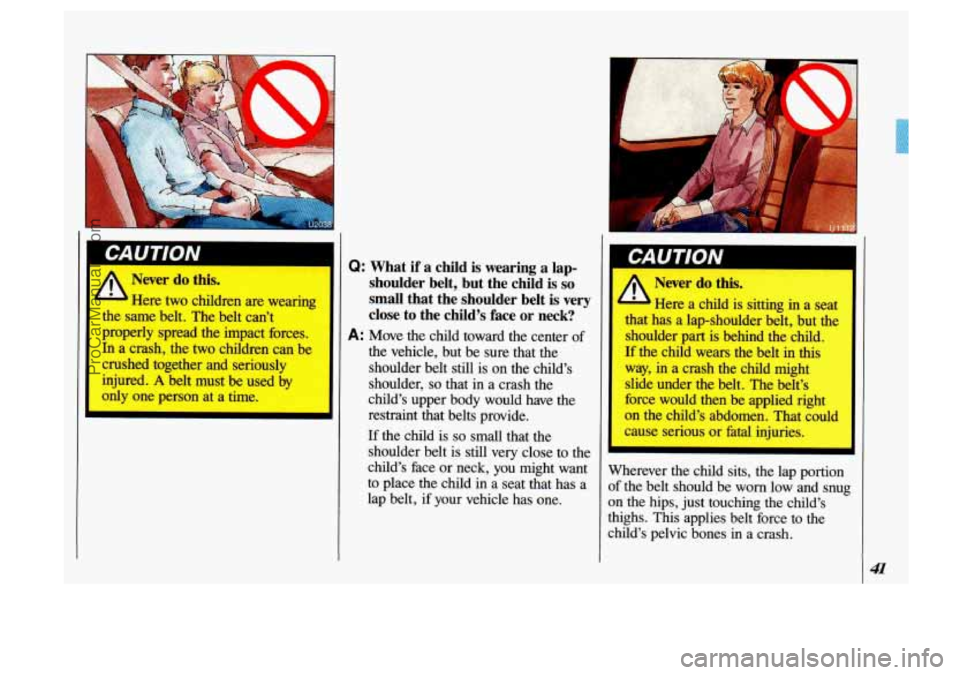
Never do this.
A Here two children are wearing
the same belt. The belt can’t
properly spread the impact forces.
In a crash, the two children can be
crushed together and seriously
injured.
A belt must be used by I
only one person at a time.
Q: What if a child is wearing a lap-
shoulder belt, but the child is
so
small that the shoulder belt is very
close to the child’s face or neck?
A: Move the child toward the center of
the vehicle, but be sure that the shoulder belt still is
on the child’s
shoulder,
so that in a crash the
child’s upper body would have the
restraint that belts provide.
If the child is so small that the
shoulder belt is still very close to the
child’s face or neck, you might want
to place the child in a seat that has a
lap belt, if your vehicle has one.
Never do this.
Here a child is sitting in a seat
that has a lap-shoulder belt, but the
shoulder part is behind the child.
If the child wears the belt in this
way, in a crash the child might
slide under the belt. The belt’s
force would then be applied right
on the child’s abdomen. That could
cause serious or fatal injuries.
I
I
Wherever the child sits, the lap portion
of the belt should be worn low and snug
on the hips, just touching the child’s
thighs. This applies belt force to the
child’s pelvic bones
in a crash.
41
ProCarManuals.com
Page 55 of 323
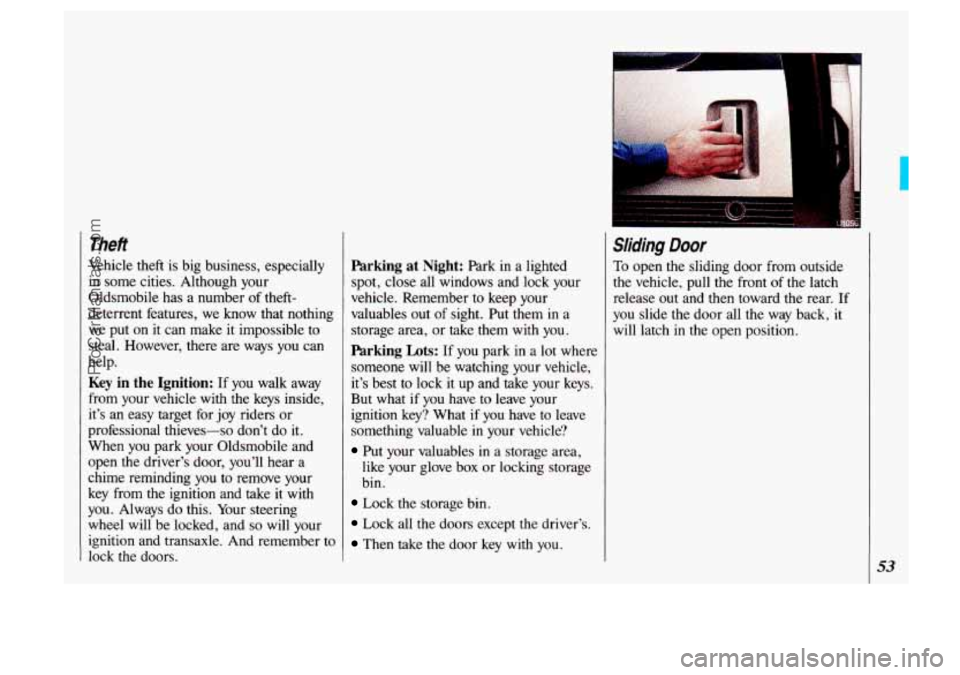
5
Theft
Vehicle theft is big business, especially
in some cities. Although your
Oldsmobile has a number of theft-
deterrent features, we know that nothing
we put on it can make it impossible
to
steal. However, there are ways you can
help.
Key in the Ignition: If you walk away
from your vehicle with the keys inside,
it's an easy target for joy riders or
professional thieves-so don't do it.
When you park your Oldsmobile and
open the driver's door, you'll hear a
chime reminding you
to remove your
key from the ignition and take it with
you. Always do this. Your steering
wheel will be locked, and
so will your
ignition and transaxle. And remember to
lock the doors.
Parking at Night: Park in a lighted
spot, close
all windows and lock your
vehicle. Remember to keep your
valuables out
of sight. Put them in a
storage area, or take them with you.
Parking Lots: If you park in a lot where
someone will be watching your vehicle,
it's best to lock it
up and take your keys.
But what if you have to leave your
ignition key? What if you have to leave
something valuable in your vehicle?
Put your valuables in a storage area,
like your glove
box or locking storage
bin.
Lock the storage bin.
Lock all the doors except the driver's.
Then take the door key with you.
Sliding Door
To open the sliding door from outside
the vehicle, pull the front
of the latch
release out and then toward the rear. If
you slide the door all the way back, it
will latch in the open position.
53
ProCarManuals.com
Page 58 of 323
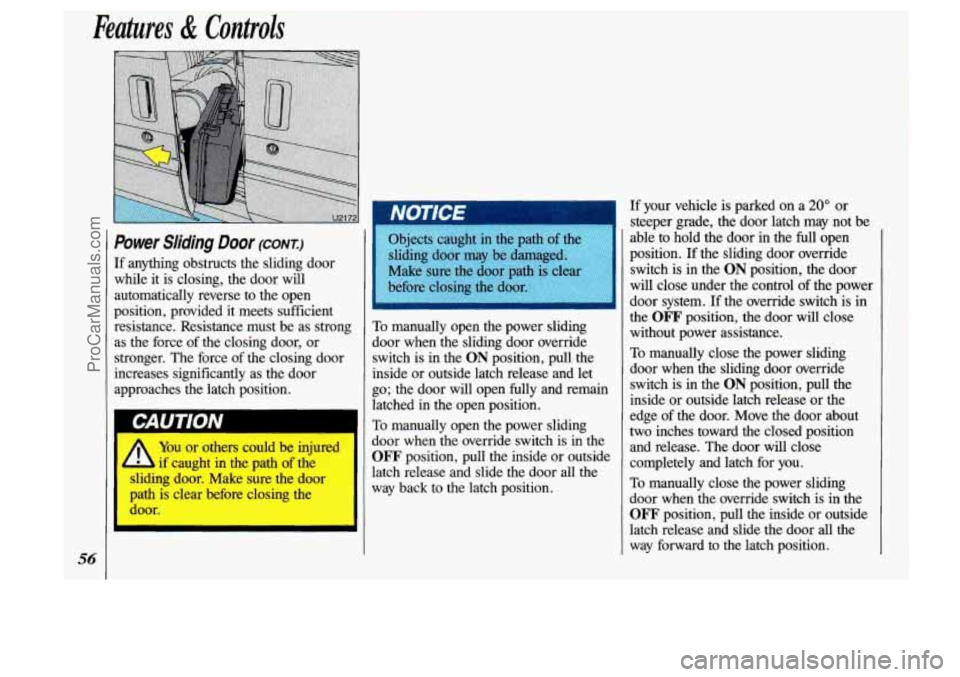
Features & Controls
56
Power Sliding Door (CONK)
If anything obstructs the sliding door
while it is closing, the door will
automatically reverse to the open position, provided it meets sufficient
resistance. Resistance must be as strong
as the force of the closing door, or
stronger. The force of the closing door
increases significantly as the door
approaches the latch position.
You or others could be injured
I
- if caught in the path of the
sliding door. Make sure the door
path is clear before closing
the
door.
To manually open the power sliding
door when the sliding door override switch is in the
ON position, pull the
inside or outside latch release and let
go; the door will open fully and remain
latched in the open position.
To manually open the power sliding
door when the override switch is in the
OFF' position, pull the inside or outside
latch release and slide the door
all the
way back to the latch position.
If your vehicle is parked on a 20" or
steeper grade, the door latch may not be
able to hold the door in the full open
position.
If the sliding door override
switch is in the
ON position, the door
will close under the control
of the power
door system.
If the override switch is in
the OFF position, the door will close
without power assistance.
To manually close the power sliding
door when the sliding door override
switch is in the
ON position, pull the
inside or outside latch release or the
edge of the door. Move the door about
two inches toward the closed position
and release. The door
will close
completely and latch for you.
To manually close the power sliding
door when the override switch is in the
OFF position, pull the inside or outside
latch release and slide the door all the
way forward to the latch position.
ProCarManuals.com
Page 62 of 323
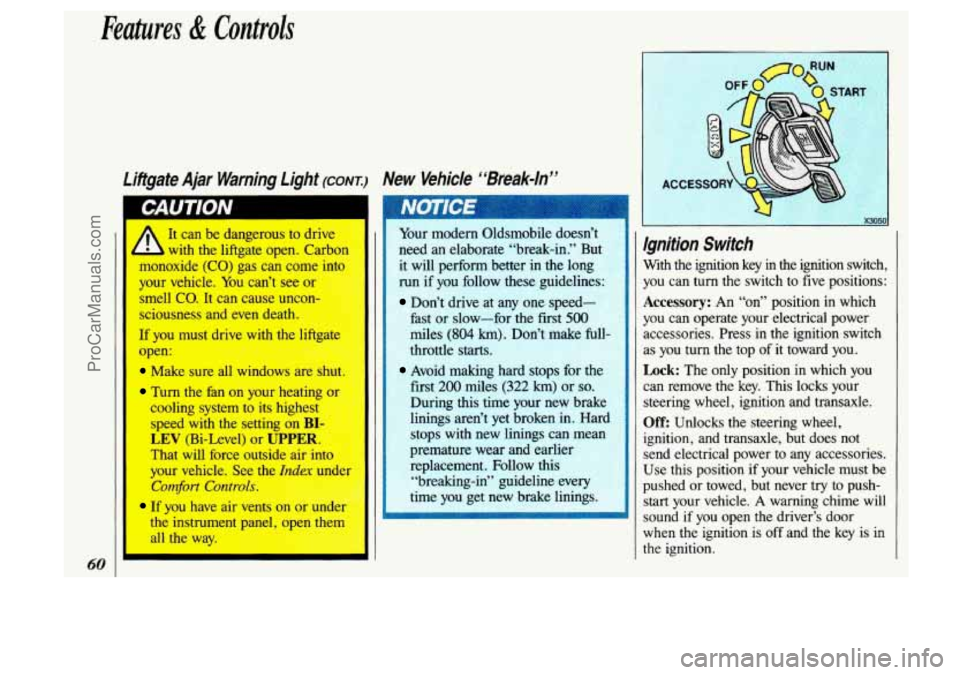
Features & Controls
60
Liitgate Ajar Warning light (CONT.) New Vehicle “Break-In”
It can be dangerous to dr’ A
b with the liftgate open. Cam
lllvnoxide
(CO) gas can come in1
your vehicle. You can’t see or
smell
CO. It can cause uncon-
sciousness and even death.
If you must drive with
tk lifti
open:
Make sure all window
Turn the fan on your heatinl
cooling system to its high--*
speed
with the setting on
LEV (Bi-Level) or UPPER
That will force outside air ir
your vehicle. See
the Index under I
Comfort Controls.
If you have air vents on or under
the instrument panel, open the1
all the way.
I
four modern Olasmobile doesnt
need
an elaborate “break-in.” But
it will
perform better in the long
run if you follow these guidelines:
Don’t drive at any one speed-
fast or slow-for the first 500
miles (804 km). Don’t make full- I
throttle starts.
Avoid making hard stops for the
first
200 miles (322 km) or so.
During this time your new brake
linings aren’t yet broken in. Hard
stops with new linings can mean
I
premature wear and earlier
I
lgnition Switch
With the ignition key in the ignition switch,
you can turn the switch to five positions:
Accessory: An “on” position in which
you can operate your electrical power
accessories. Press in the ignition switch
as you turn the top of it toward you.
Lock: The only position in which you
can remove the key. This locks your
steering wheel, ignition and transaxle.
Off: Unlocks the steering wheel,
ignition, and transaxle, but does not
send electrical power to any accessories.
Use this position if your vehicle must be
pushed or towed, but never try to push-
start your vehicle. A warning chime will
sound if
you open the driver’s door
when the ignition is off and the key is in
the ignition.
ProCarManuals.com
Page 65 of 323
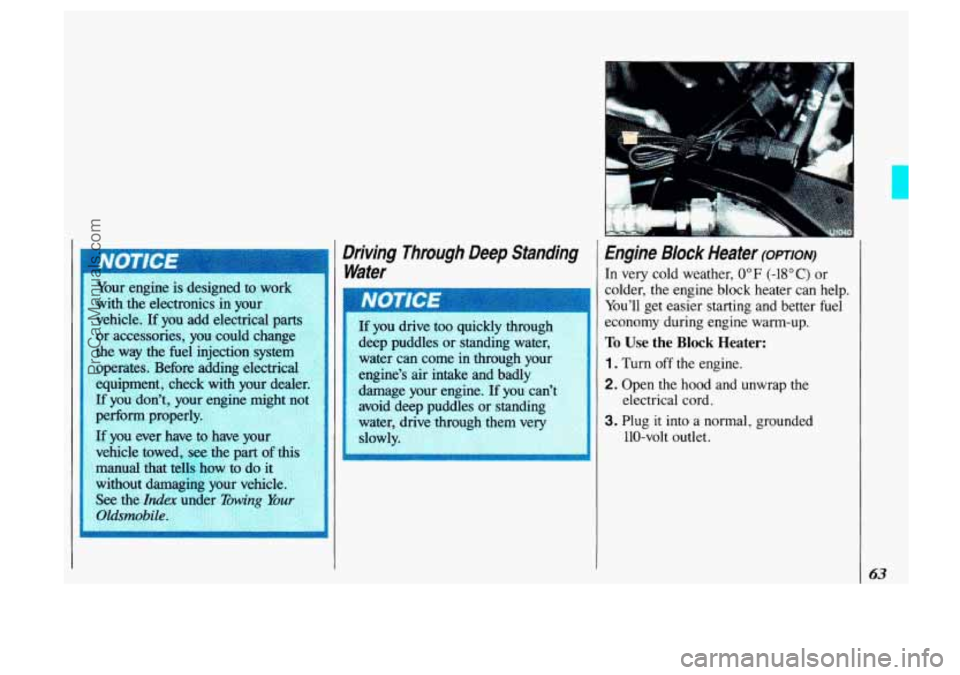
with the electronics in your
vehicle. If you add electrical parts
or accessories, you could change
the
way the fuel injection system
operates. Before adding electrical
equipment, check with your dealer.
If you don't, your engine might not
perform properly.
If you ever have to have your
manual that tells how to do it
without damaging your vehicle.
See the Index under Towing Your
Oldsmbile.
vehicle towed, see the part of this
Driving Through Deep Standing
Water
engine's air intake and badly
'I
Engine Block Heater (oprlofv)
In very cold weather, 0" F (-18°C) or
colder, the engine block heater can help.
You'll get easier starting and better fuel
economy during engine warm-up.
To Use the Block Heater:
1. Turn off the engine.
2. Open the hood and unwrap the electrical cord.
3. Plug it into a normal, grounded
110-volt outlet.
63
ProCarManuals.com
Page 67 of 323
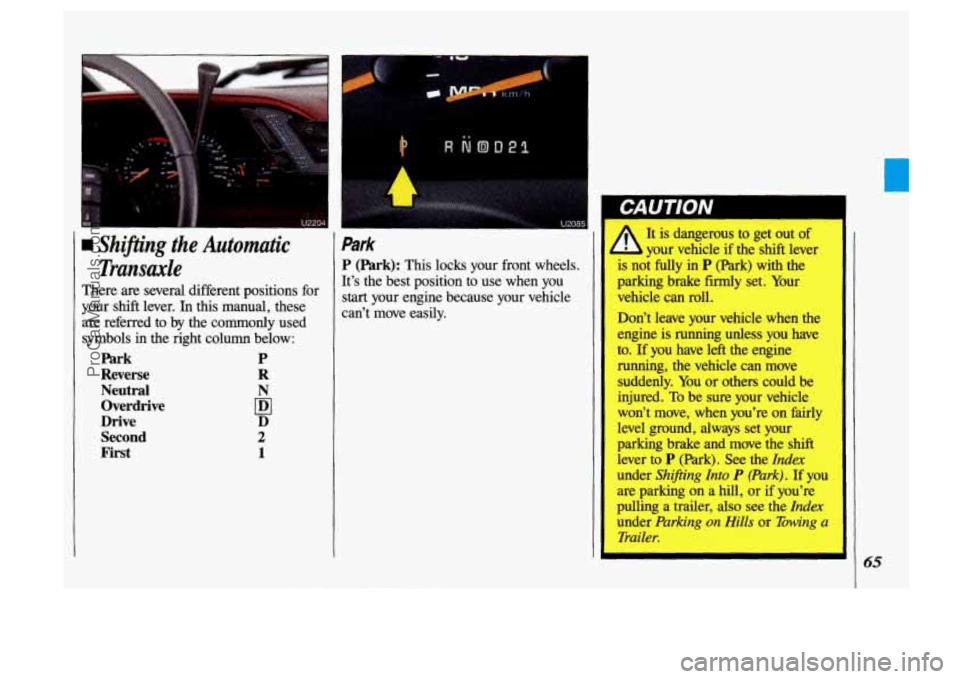
Sh#ting the Automatic
Tranm.de
There are several different positions for
your shift lever.
In this manual, these
are referred
to by the commonly used
symbols
in the right column below:
Park P
Reverse R
Neutral
Overdrive
&
Drive D
Second 2
First 1
Park
P (Park): This locks your front wheels.
It's the best position to use when you
start your engine because your vehicle
can't move easily. It
is dangerous to get out of
A your vehicle if the-shift lever
1s not fully in P (Park) with the
parking brake firmly set. Your
vehicle can roll.
Don't leave your vehicle when the
engine is running unless you have
to.
If you have left the engine
running, the vehicle can move suddenly. You or others could be
injured.
To be sure your vehicle
won't move, when you're on fairly
level ground, always set your
parking brake and move the shift lever to
P (Park). See the Index
under Shifting Into P (Park). If you
are parking
on a hill, or if you're
pulling a trailer, also see the
Index
under Parking on Hills or Towing a
Trailer.
ProCarManuals.com
Page 68 of 323
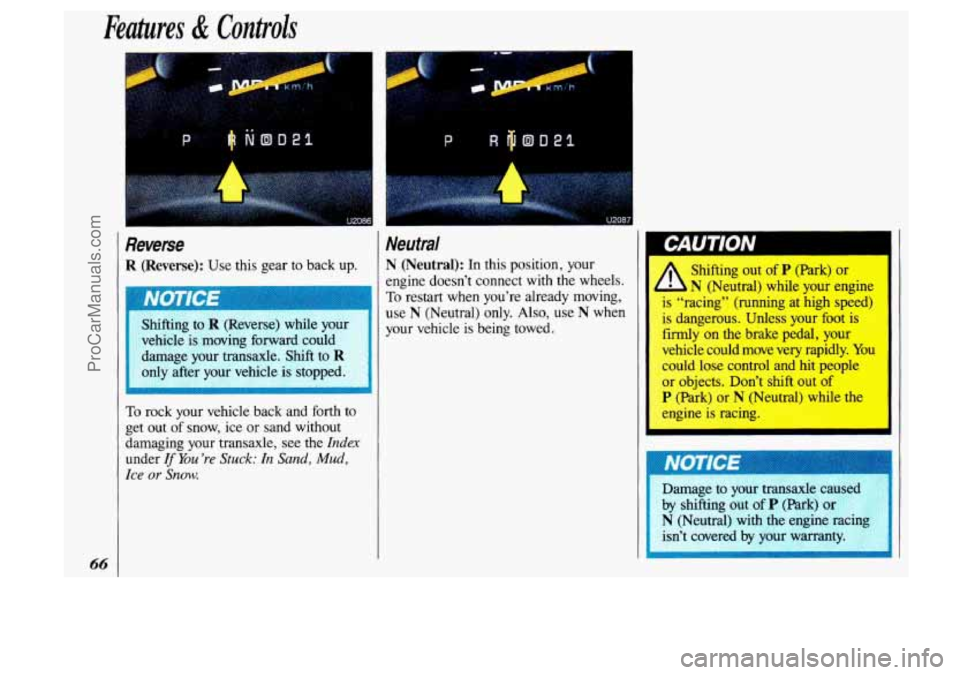
Features & Controls
66
Reverse
R (Reverse): Use this gear to back up.
To rock your vehicle back and forth to
get out
of snow, ice or sand without
damaging your transaxle, see the
Index
under If You 're Stuck: In Sand, Mud,
Ice or Snow.
Neutral
N (Neutral): In this position, your
engine doesn't connect with the wheels.
To restart when you're already moving,
use
N (Neutral) only. Also, use N when
your vehicle
is being towed.
A
Shifting out of P (Park) or
N (Neutral) while your engine
is "racing" (running at high speed'
is dangerous. Unless your foot
is
firmly on the brake pedal, your
vehicle could move
very rapidly. You
could lose control and hit people
or objects. Don't shift out of
P (Park) or N (Neutral) while the
engine is racing.
~~
I;
: Damage to your transde.caused
by shifting out of P (Park) 0:
N (Neutral) with the engine racing
isn't covered
by your warranty.
ProCarManuals.com
Page 69 of 323
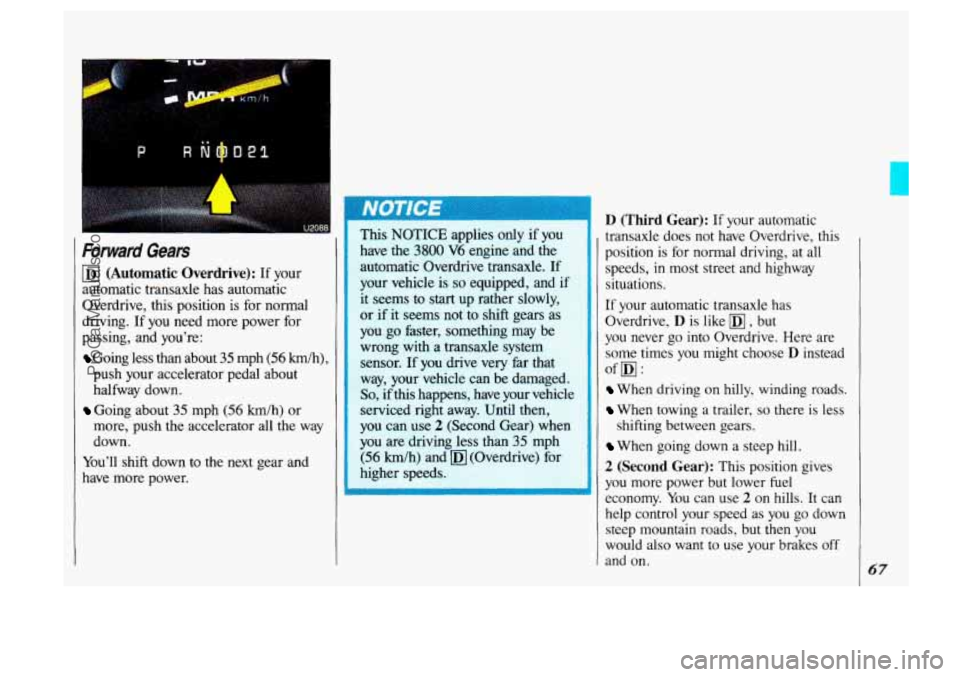
Fonvard Gears
(DI (Automatic Overdrive): If your
automatic transaxle has automatic
Overdrive, this position is for normal
driving.
If you need more power for
passing, and you’re:
Going less than about 35 mph (56 km/h),
push your accelerator pedal about
halfway down.
Going about 35 mph (56 km/h) or
more, push the accelerator all the way
down.
You’ll shift down to the next gear and
have more power. have
the
3.800 V6-engine and the
automatic Overdrive transaxle. If
your vehicle
is so equipped, and if
it seems to
start up rather slowly,
or if it seems not to shift gears as
you go faster, something may be
wrong with a transaxle system
sensor. If you drive very far that
way, your vehicle can be damaged.
So, if this happens, have your vehicle
serviced right away. Until then,
you can use
2 (Second Gear) when
you are driving less than
35 mph
(56 km/h) and (Overdrive) for
higher speeds? . --~ :~~~ - ~ , ~~. =-== ~~ ~=~ ~ .=- .~ ~..~ ..~... .~.= ~~ . .. .. .. ..
D (Third Gear): If your automatic
transaxle does not have Overdrive, this
position is for normal driving, at all
speeds, in most street and highway
situations.
If your automatic transaxle has
Overdrive,
D is like , but
you never go into Overdrive. Here are
some times you might choose
D instead
When driving on hilly, winding roads.
When towing a trailer, so there is less
When going down a steep hill.
2 (Second Gear): This position gives
you more power but lower fuel
economy. You can use
2 on hills. It can
help control your speed as you go down
steep mountain roads, but
then you
would also want to use your brakes off
and on.
ofH:
shifting between gears.
67
ProCarManuals.com